AMD's Sempron 3300+: 90nm Budget Computing
by Anand Lal Shimpi on April 18, 2005 2:10 AM EST- Posted in
- CPUs
Workstation Applications
SPECviewperf 8
For our next set of professional application benchmarks, we turn to SPECviewperf 8. SPECviewperf is a collection of application traces taken from some of the most popular professional applications, and compiled together in a single set of benchmarks used to estimate performance in the various applications that the benchmark is used to model. With version 8, SPEC has significantly improved the quality of the benchmark, making it even more of a real world indicator of performance.
We have included SPEC's official description of each one of the 8 tests in the suite.
Not too surprising is the strong performance of the Sempron here; the chip's on-die memory controller ensures very good performance in all of the SPECviewperf tests.
3dsmax Viewset (3dsmax-03)
"The 3dsmax-03 viewset was created from traces of the graphics workload generated by 3ds max 3.1. To ensure a common comparison point, the OpenGL plug-in driver from Discreet was used during tracing.
The models for this viewset came from the SPECapc 3ds max 3.1 benchmark. Each model was measured with two different lighting models to reflect a range of potential 3ds max users. The high-complexity model uses five to seven positional lights as defined by the SPECapc benchmark and reflects how a high-end user would work with 3ds max. The medium-complexity lighting models use two positional lights, a more common lighting environment.
The viewset is based on a trace of the running application and includes all the state changes found during normal 3ds max operation. Immediate-mode OpenGL calls are used to transfer data to the graphics subsystem."
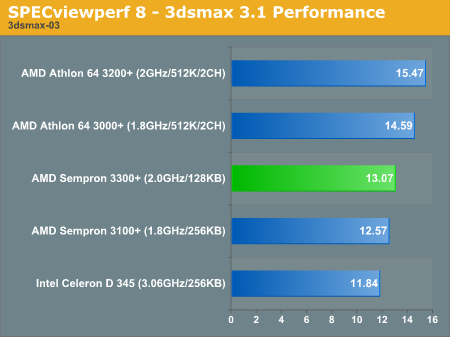
CATIA Viewset (catia-01)
"The catia-01 viewset was created from traces of the graphics workload generated by the CATIATM V5R12 application from Dassault Systems.
Three models are measured using various modes in CATIA. Phil Harris of LionHeart Solutions, developer of CATBench2003, supplied SPEC/GPC with the models used to measure the CATIA application. The models are courtesy of CATBench2003 and CATIA Community.
The car model contains more than two million points. SPECviewperf replicates the geometry represented by the smaller engine block and submarine models to increase complexity and decrease frame rates. After replication, these models contain 1.2 million vertices (engine block) and 1.8 million vertices (submarine).
State changes as made by the application are included throughout the rendering of the model, including matrix, material, light and line-stipple changes. All state changes are derived from a trace of the running application. The state changes put considerably more stress on graphics subsystems than the simple geometry dumps found in older SPECviewperf viewsets.
Mirroring the application, draw arrays are used for some tests and immediate mode used for others."
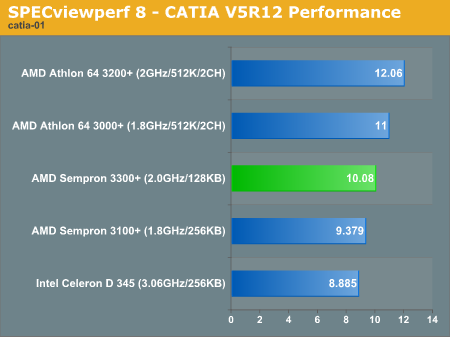
Lightscape Viewset (light-07)
"The light-07 viewset was created from traces of the graphics workload generated by the Lightscape Visualization System from Discreet Logic. Lightscape combines proprietary radiosity algorithms with a physically based lighting interface.
The most significant feature of Lightscape is its ability to simulate global illumination effects accurately by precalculating the diffuse energy distribution in an environment and storing the lighting distribution as part of the 3D model. The resulting lighting "mesh" can then be rapidly displayed."
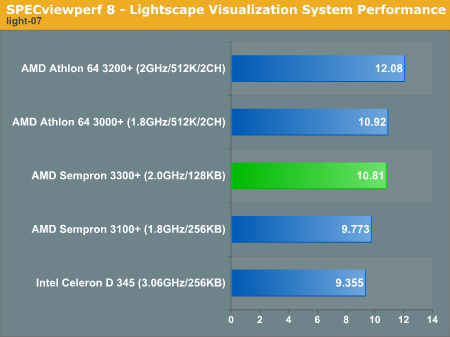
Maya Viewset (maya-01)
"The maya-01 viewset was created from traces of the graphics workload generated by the Maya V5 application from Alias.
The models used in the tests were contributed by artists at NVIDIA. Various modes in the Maya application are measured.
State changes as made by the application are included throughout the rendering of the model, including matrix, material, light and line-stipple changes. All state changes are derived from a trace of the running application. The state changes put considerably more stress on graphics subsystems than the simple geometry dumps found in older viewsets.
As in the Maya V5 application, array element is used to transfer data through the OpenGL API."
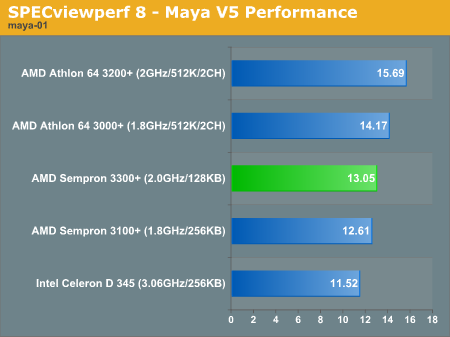
Pro/ENGINEER (proe-03)
"The proe-03 viewset was created from traces of the graphics workload generated by the Pro/ENGINEER 2001TM application from PTC.
Two models and three rendering modes are measured during the test. PTC contributed the models to SPEC for use in measurement of the Pro/ENGINEER application. The first of the models, the PTC World Car, represents a large-model workload composed of 3.9 to 5.9 million vertices. This model is measured in shaded, hidden-line removal, and wireframe modes. The wireframe workloads are measured both in normal and antialiased mode. The second model is a copier. It is a medium-sized model made up of 485,000 to 1.6 million vertices. Shaded and hidden-line-removal modes were measured for this model.
This viewset includes state changes as made by the application throughout the rendering of the model, including matrix, material, light and line-stipple changes. The PTC World Car shaded frames include more than 100MB of state and vertex information per frame. All state changes are derived from a trace of the running application. The state changes put considerably more stress on graphics subsystems than the simple geometry dumps found in older viewsets.
Mirroring the application, draw arrays are used for the shaded tests and immediate mode is used for the wireframe. The gradient background used by the Pro/E application is also included to better model the application workload."
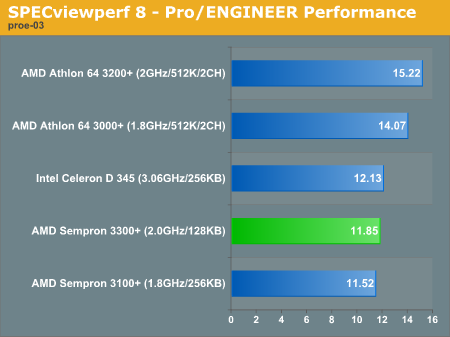
SolidWorks Viewset (sw-01)
"The sw-01 viewset was created from traces of the graphics workload generated by the Solidworks 2004 application from Dassault Systemes.
The model and workloads used were contributed by Solidworks as part of the SPECapc for SolidWorks 2004 benchmark.
State changes as made by the application are included throughout the rendering of the model, including matrix, material, light and line-stipple changes. All state changes are derived from a trace of the running application. The state changes put considerably more stress on graphics subsystems than the simple geometry dumps found in older viewsets.
Mirroring the application, draw arrays are used for some tests and immediate mode used for others."

Unigraphics (ugs-04)
"The ugs-04 viewset was created from traces of the graphics workload generated by Unigraphics V17.
The engine model used was taken from the SPECapc for Unigraphics V17 application benchmark. Three rendering modes are measured -- shaded, shaded with transparency, and wireframe. The wireframe workloads are measured both in normal and anti-alised mode. All tests are repeated twice, rotating once in the center of the screen and then moving about the frame to measure clipping performance.
The viewset is based on a trace of the running application and includes all the state changes found during normal Unigraphics operation. As with the application, OpenGL display lists are used to transfer data to the graphics subsystem. Thousands of display lists of varying sizes go into generating each frame of the model.
To increase model size and complexity, SPECviewperf 8.0 replicates the model two times more than the previous ugs-03 test."
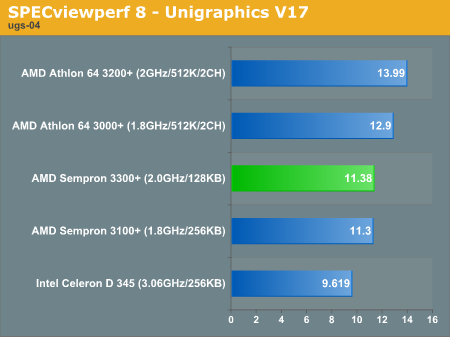










53 Comments
View All Comments
Bapster - Monday, April 18, 2005 - link
Why dont they use a mid-range video card with a budget cpu ???It's like buying an FX-55 and using a 9250 Readon
These articles would be better using an X700 or 6600 GT .
But thats only my two cents.
PrinceGaz - Monday, April 18, 2005 - link
sorry my reply was meant for #7PrinceGaz - Monday, April 18, 2005 - link
#6- the review says "The Sempron 3300+ has a default core voltage of 1.400V, bumping it to 1.500V and increasing the FSB to 240MHz yielded us a nice and even 2.4GHz, a 20% increase in clock frequency."That wording suggests they did not attempt to find how fast it could go, only that they chose 2.4GHz because it was a convenient speed (a straight 20% increase) to see how much difference it made in real-world performance. I would be interested to know just how high it could go to both at default voltage and a modest overvolting.
bupkus - Monday, April 18, 2005 - link
#7 Yes, and of course the Celeron D can easily OC to 3.6GHz; I have a 320 that does that quite handily. But I still got the point the author was trying to make. Overclocking a cpu with limited cache has limited benefit as it still operates best within it's strengths.bobsmith1492 - Monday, April 18, 2005 - link
Visual -http://www.anandtech.com/news/shownews.aspx?i=2411...
This news post? I don't see any removed news post.... chill with the conspiracy theories.
Visual - Monday, April 18, 2005 - link
ok what's with this? there was a news post about someone else's review of 3300+, i think from april 15th, now you post your own review and remove the news post? why'd you remove the newspost?DrMrLordX - Monday, April 18, 2005 - link
You guys only hit 2.4 ghz on the Sempron 3300+? Man, all the OCs I've seen on the 2600+ and 2800+ have hit 2.4 ghz fairly easily. My 2800+ hit 2.4 ghz with a vcore bump, and 2.3 ghz without any vcore adjustments at all on the stock heatsink. All that, with 256k l2 cache.The 3300+ doesn't seem like a very good choice for overclocking compared to the 90 nm 2800+ and 3100+(yes, there are 90 nm 3100+ cpus out there).
snedzad - Monday, April 18, 2005 - link
According to latest unofficial AMD roadmap (http://www.hkepc.com/bbs/attachments/amdroadmap_bc... it doesn't seem that Sempron will ever be available for 939 sck. Both 754 and 939 will be replaced with M2 socket in 2nd half of 2006.plewis00 - Monday, April 18, 2005 - link
Probably because they consider dual-channel memory a high-end thing and don't want to pass it down to the budget-end, the same thing with HT and Intel Celerons.Anyway someone said AMD are releasing an S939 Sempron didn't they?
arfan - Monday, April 18, 2005 - link
why there is no sempron 4 socket 939 ? i want to buy socket 939 + sempron